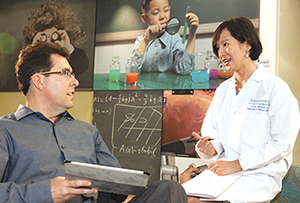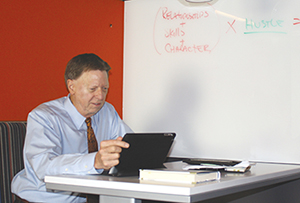BY KATHLEEN NELSON
Fresh solutions in health care require fresh perspectives. To that end, several ministry members have developed innovation hubs — spaces outside the hospital designed to be more conducive to creativity, collaboration and risk-taking.
While each space has the requisite whiteboards to map and edit ideas, and two have idea spaces called "The Garage" in homage to the humble work space where the Apple computer was invented, their approaches to innovation and collaboration vary.

Larry Stofko, executive vice president of the Innovation Institute in Newport Beach, Calif., talks to Dr. Connie Bartlett, a pediatrician, about her idea for a medical device that helps alleviate pain and fear for children in a clinical setting. Bartlett is president of the St. Joseph Heritage Medical Group, part of St. Joseph Health system.
The Innovation Institute in Newport Beach, Calif., was started by St. Joseph Health in January 2013 and counts three other CHA members among its five "member owner" health systems. Physicians, nurses and other member health system staff contribute ideas for medical devices and patient care services. The institute's industrial, technology and academic partners are involved in evaluating and developing ideas.
Mercy houses its own innovation experts and welcomes other systems to its innovation hub on the fourth floor of its new Virtual Care Center in Chesterfield, Mo.
And in Grand Rapids, Mich., Mercy Health shares creative space with commercial industries, harvesting ideas from the for-profit world that could benefit its parent, Trinity Health system of Livonia, Mich.
Each of the hubs has projects in various stages of secrecy and development, but at least one that they're willing to share.
Here's a closer look at each hub.
Innovation Institute: Surf's up
Decorative surfboards resting against the lobby wall at the Innovation Institute's incubator/lab in Newport Beach, bear the names of member owners. In addition to Irvine, Calif.-based St. Joseph Health, that list includes Baton Rouge, La.-based Franciscan Missionaries of Our Lady Health System; Marriottsville, Md.-based Bon Secours Health System; Orange, Calif.-based Children's Hospital of Orange County; and, as of December, Sioux Falls, S.D.-based Avera Health. The Innovation Institute is in negotiations with two additional potential member owners.

Roger Spoelman, president and chief executive of Mercy Health's West Michigan Region, often works at the Innovation Hub in Grand Rapids. He uses a whiteboard to brainstorm and write motivational messages to the staff.
Although technology connects institute staff with local teams at member institutions around the country, inventors and owners also come to Newport Beach to work out ideas for inventions that hold promise for improving care and reducing costs, and to learn about technology transfers and product development from subject matter experts. Many of the work spaces have sweeping views of the Pacific Ocean.
"We wanted our lab to be a place that's a destination," said Joe Randolph, president and chief executive of the Innovation Institute. "When you see the ocean and experience the ambiance, it fosters creativity and a sense of calm that helps you work better as a group."
The ocean theme continues in the long board, deep dive and blue oceans rooms, meeting spaces for 15 to 70 people, and in the wave café. The ceiling of the inspiration room features three wave sculptures running the length of the space.
"Since so many of our member owners are from Catholic health systems, they see the waves standing for the Father, Son and Holy Spirit," Randolph said.
And for its partners and affiliates not lucky enough to have the beach outside their window, the Innovation Institute broadcasts a live online feed of its view of the Pacific.
Since its opening, the Innovation Institute has received more than 340 product ideas from member systems and about 90 ideas from the general public, according to Francine Marlenee, the organization's communications manager. Most of the ideas are for medical devices. About 30 projects have merited further development. Products being marketed include VisuFlow, a software program that replaces text-heavy health care process diagrams with simple, intuitive visuals, and ExerFloat, an aquatic exercise device for people with back pain.
Mercy immersion
To reach Mercy's innovation center at its Virtual Care Center, visitors pass Mercy's tribute to its founders, the Sisters of Mercy, on the first floor then take an escalator to the system's advanced center where 330 clinicians deliver virtual care, before emerging two floors above in a glass-walled space with a treetop view.
"They see that we respect tradition, then they see that virtual care can really work. By the time they come up here, they're thinking, 'I want to work here,'" said Dr. Tom Hale, executive medical director of Mercy Virtual Care.
Despite an abundance of hard surfaces, glass and whiteboards, and an open ceiling, acoustic design keeps noise to a minimum, making the space conducive for distraction-free, creative thinking. Black spray foam, which covers the ceiling, rafters, air ducts and conduits, keeps sound from bouncing, according to Ken Newbury, senior vice president of operations at McCann Systems, which designed the audiovisual systems for the design center.
McCann's video system in the center of the space includes 27 video monitors stacked in three rows. The monitors use a technology called Mezzanine, which can display a single image across their expanse or as many as 27 work spaces. A remote akin to a laser pointer can rearrange the visuals on each screen.
"You never know which screen placed where will provide the epiphany moment," Hale said.
A half-dozen whiteboard walls roll in tracks perpendicular to the video display area — Mercy associates who dial into brainstorming sessions remotely can see the boards via video links. Cushioned ottomans on casters roll out from under the display to provide flexible seating. Adjoining this space are offices for members of Mercy Virtual staff: medical directors, nursing leaders, operational leaders, business development, technology services, care management leaders and executive leadership.
"If a question comes up in a session, we'll call them in," Hale said. "It's ad hoc thinking that gives us greater flexibility."
Since opening in October, The Garage has been the site of one to six meetings a day. Some have been for Mercy staff exclusively; some have included representatives from other health systems.
Among Mercy's innovations is an app for tablets that athletic trainers will be able to use on the field to assess concussions. The software allows a coach to compare a player's responses after a hard hit to the player's baseline cognitive test results and eye-movement tracking — information that allows for a more accurate assessment of whether a player should return to action. Hale said Mercy will test the app with high school teams in the St. Louis area before making it available to high school, college and pro teams across the country.

The treetop view from the top floor of Mercy's Virtual Care Center in Chesterfield, Mo., which houses its innovation space.
Mercy Health: On the GRid
Ben Look contemplates the changing skyline and street life in downtown Grand Rapids, from Mercy Health's Innovation Hub on the top floor of a former hotel.
"People laugh at me because I sit there and look out over downtown," said Look, Mercy Health's regional director for project management and operations improvement. "You see the high rises above, the community gatherings below. With the constant change, there's no way you can't be inspired to change, too."
The complex is called GRid70, Grand Rapids Innovation and Design, and it also houses innovation hubs for commercial industries: Meijer, a regional chain of grocery and general merchandise stores; Amway, purveyors of health, beauty and home products; Urbaneer, which designs and manufactures wall systems and multipurpose furnishings; and Wolverine Worldwide, owner of such shoe brands as Hush Puppies, Keds, Saucony and Wolverine. All are eager to swap tips when they gather at "Lunch and Learns" or "Waffle Wednesdays."
"There is no hesitancy when it comes to collaboration," Look said. "It lets us skip ahead and learn from their mistakes."
Mercy Health has launched a partnership with Urbaneer, incorporating some of the company's products at GRid70, and hopes to use its space-saving savvy in primary care offices to make more efficient use of space.
"Real estate is very expensive in health care," Look said. "We have outstanding health care knowledge, but we're not space planners. We're able to tap into that kind of expertise here. That idea came up while we were eating sandwiches."
Since launching in July, Mercy Health has hosted more than 100 meetings for staff from the system and Trinity Health. The key, Look said, is top-down buy-in. He often sees Roger Spoelman, president and chief executive of Mercy Health West Michigan Region, who comes to GRid70 to gather his thoughts.
"He'll carve out a little whiteboard space in a corner, and he often has something pretty inspirational written there," Look said. "It sets a standard when the leadership is committed. They walk the walk."
Copyright © 2016 by the Catholic Health Association
of the United States
For reprint permission, contact Betty Crosby or call (314) 253-3477.